Canon Rangefinder 135 mm Lenses
A Description of Canon Rangefinder 135 mm Telephoto Lenses produced 1947-1975
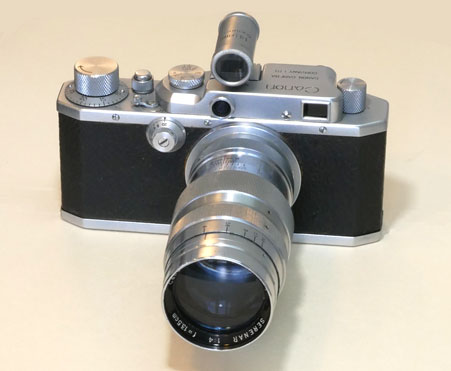
a Canon 13.5cm f4.0 of 1948 with finder on a contemporaneous Canon S-II
Canon's development of the 135mm telephoto lens
In March 1947, Canon released the second lens of Canon manufacture: the Canon 13.5cm f4.0. The first had been the 5cm f3.5 beginning in 1946. The Serenar 13.5cm f4.0 without rangefinder coupling was released in March 1947 by Seiki-Kogaku. 2,330 of these lenses without rangefinder coupling were manufactured before, in December 1947 the lens was upgraded to have rangefinder coupling.
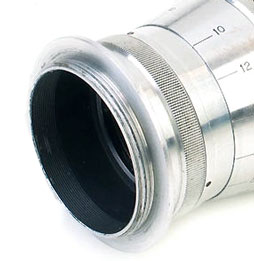
an uncoupled Serenar 13.5cm f4.0 telephoto of 1947 with distance scale in feet
During 1948, the year of the 13.5cm f4.0 telephoto shown in the photograph above, the name on the lens was changed to "Canon Camera Company Ltd." reflecting the company name change on September 9, 1947.
The Serenar 13.5cm f4.0 coupled lens was a design of 4 elements in 3 groups, and had a smallest aperture of f16. It accepted a 40mm screw-in adapter ring for all accessories.
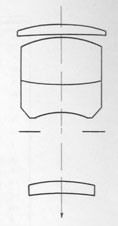
Serenar 13.5cm f4.0 design
This rangefinder coupled lens continued in production until October, 1952, by that time totaling 14,375 lenses manufactured - an impressive total for that era. 2
At the time of the introduction of the rangefinder coupled 13.5cm, Canon began to apply 'Spectra Coating' to the lens surfaces. (This term was also later applied to Canon lenses two decades later when the "Super Spectra Coating" or S.S.C. applied to new breach lock FD lenses for Canon single lens reflex cameras.) Also, in 1949, Canon began applying the millimeter description to all of its lenses, so this telephoto became the 135mm F4.0.
Canon 135mm f3.5 telephoto
In October 1952, Canon introduced their new 135mm f3.5 telephoto. This was a few months after Canon's introduction of the new, very fine Serenar/Canon 50mm f1.8 in a new rigid mount finished in satin chrome - also the case with the new 135mm f3.5.
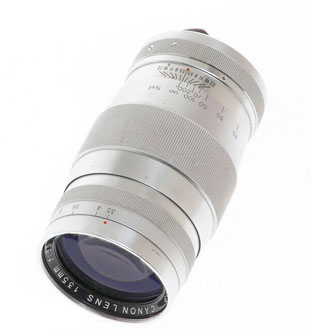
the new satin chrome Canon 135mm f3.5
The Serenar 13.5cm f3.5 lens was a design of 4 elements in 3 groups, and its smallest aperture was now f22. It accepted a 48mm screw-in adapter ring fors Series VII accessories. accessories.
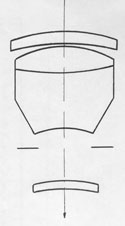
Canon 135mm f3.5 design
Canon actively promoted the 135mm f3.5, particularly with what was perhaps its most important new camera of the early 1950s, the Canon IVSB of December 1952. Among other important innovations, the Canon IVSB, according to Canon's history website 4, was also the world's first camera synchronized for electronic strobe flash as well as flash bulb. The IVSB viewfinder/rangefinder had a viewing position for a 135mm lens, and Canon also supplied an accessory viewfinder with parallax correction. The IVSB of 1952 featured a full range of lenses, including the Canon 135mm f3.5 in satin chrome finish which was actively promoted.
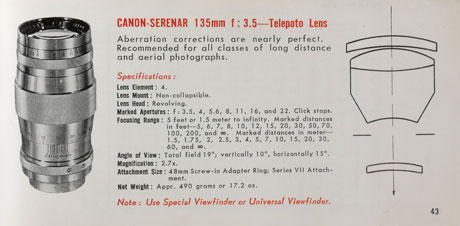
In April 1958, Canon introduced the new black barrel version of the 135mm f3.5 in a lighter alloy body to match the other lenses in the Canon range with this new look. The 135mm f3.5 weight in this stronger, lighter alloy was 437 grams, compared with the previous 577 grams, a 25% lighter lens - important given the torque exercised by the heavy, long telephoto lens on the lens mounting and camera body.
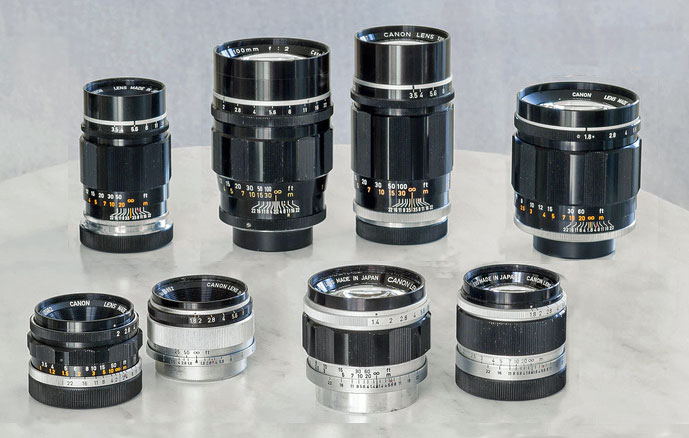
Canon range in the new barrel alloy, black finish upgrade:
top (l to r): 100mm f3.5, 100mm f2.0, 135mm f3.5, 85mm f1.8
bottom (l to r): 35mm f2.0, 35mm f1.8, 50mm f1.4, 50mm f1.8
History of Canon 135mm lenses
An interesting history of the development of the Canon 135mm lens was given in vade mecum, a book issued in limited edition in 1997. 19 This book contained a photograph of all the Canon/Serenar 135mm lenses from the first uncoupled 135mm of January 1947 to the 1958-1975 135mm f3.5 in its black barrel finish. This photograph is shown below.
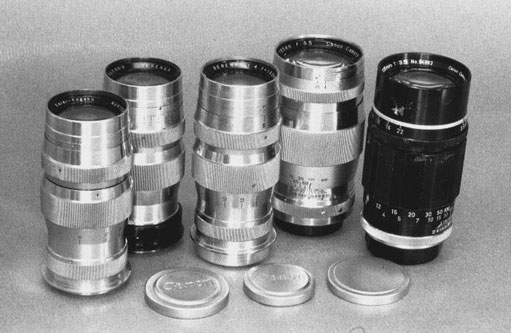
(l to r): two different uncoupled Serenar 135mm f4.0 lenses from 1947, first being calibrated in meters and the second in feet, the Serenar 135mm f4.0 rangefinder coupled lens of December 1947, the Canon 135mm f3.5 lens in chrome finish, and the final Canon 135mm f3.5 lens in black. 19
Success of the Canon 135mm f3.5
The new black barrel Canon 135mm f3.5 continued in production until Canon ended manufacture of rangefinder lenses in 1975. This lens sold a very impressive 40,476 units. 2 This was following the sales of the 19,011 units sold of the chromium finished lens. So, the 135mm focal length telephoto was Canon's second lens in production in 1947 and also among the last of Canon's rangefinder lenses in 1975 - an impressive history.
You can click on the links in the table below to consult other pages of the canonrangfinder.org site.
| Navigation: Click Below to Jump to Desired Subject Page | ||
|---|---|---|
| Canon Rangefinder Cameras - 1 | Canon Rangefinder Cameras - 2 | Canon Rangefinder Lenses |
| Canon S | Canon IVSB2 | Canon 19mm |
| Canon J | Canon IIS2, IID2, IIF2 | Canon 25mm |
| Canon NS | Canon VT, Canon L2 | Canon 28mm |
| Canon JS | Canon L1, L3 | Canon 35mm |
| Canon J-II | Canon VT Deluxe | Nikkor 50mm |
| Canon S-II | Canon VL, VL2 | Canon 50mm |
| Canon IIB | Canon VI-L, VI-T | Canon 85mm |
| Canon III, IIC, IV | Canon P | Canon 100mm |
| Canon IIIA, IVF, IVS | Canon 7 | Canon 135mm |
| Canon IIA, IID, IID1 | Canon 7s | Canon 200mm-1000mm |
| Canon IVSB | Minolta Rangefinders | Minolta Lenses |
| Canon IIF, IIS | Other Rangefinders | other M39 lenses |
| Go to canonrangefinder.com home page | ||
Any additions or corrections to these pages would be welcome simply by contacting this site as shown at the foot of this page .
Footnotes:
1 Dechert, Peter. Canon Rangefinder Cameras 1933-1968. Hove Collectors Books. West Sussex, United Kingdom. 1985. ISBN 0-906447-30-5.
Peter Dechert's book is the most important expert source of information regarding Canon Rangefinder Cameras.
2 Kitchingman, Peter. Canon M39 Rangefinder Lenses 1939-1971. A Collector's Guide. Published by Peter Kitchingman. Perth, Australia. 2008. ISBN 978-0-646-48144-9.
Peter Kitchingman's book is the definitive study of the more than three decades of M39 format camera lenses developed for Canon Rangefinder Cameras.
3 Nostalgic Canon Camera Book. 懐かしいキヤノン EI Publishing Co. Ltd. Tokyo, Japan. June 2003.
Peter Kitchingman's book is the definitive study of the more than three decades of M39 format camera lenses developed for Canon Rangefinder Cameras.
4 "Canon Camera Museum" history website. https://global.canon/en/c-museum/history/ published by Canon, Inc. accessed in 2019.
5 Rajner, Hans P. (author), John Wade (editor). Leica Copies. Classic Collections Publications. London, UK. ISBN 13: 9781874485056
Hans P. Rajner's book is an excellently detailed and carefully researched study of camera from around the world which used the Leica M39 lens mount and the same lens to film plane distance.
7 Dechert, Peter. Canon Single Lens Reflex Cameras 1959-1991. Historical Camera Publications. Yakima, Washington. 1992. ISBN 1-879561-04-2.
8 Tomlinson, Shawn M. The Film Photography Book. Lulu Pulbications. 2016. ISBN: 9781365263972
9 Sartorius., Ghester. Identifying Leica Lenses. Classic Camera 19. Tokyo, Japan. 2001. ISBN 4-257-12029-0
10 website http://www.nicovandijk.net/rflensmatrix.htm consulted 2019.
11 O'Reagan, Douglas M. Allied Exploitation of German Science after World War II. Johns Hopkins University Press. Baltimore, Maryland. 2019. ISBN 9781421428888
12 website www.canonrangefinder.servehttp.com consulted 2008.
13 Minolta expert Andrea Aprà has posted information on minoltarangefinders group and other groups and further detailed information by email. (thanks Andrea !)
14 website http://www.collection-appareils.fr/objectifs/ consulted 2019.
15 Small, Marc James. Non-Leitz Leica Thread-Mount Lenses. Wittig Books. Hückelhoven, Germany. 1997. ISBN 3-930359-47-2.
16 the Nikon Corporation website: https://imaging.nikon.com/history/ consulted 2019.
17 p 152. Ray, Sidney F. Photographic Lens ISBN 9780240510323
18 website http://www.rokkorfiles.com/Lens%20History.html accessed 2019
19 Wilkinson, M. and Glanfield, C. A Lens Collector's vade mecum Draft Paper Edition 1997. revised 2001.
If you have any comments or questions about this Canon Rangefinder site, please e-mail me (Larry Huffman) at e-mail address: [email protected]